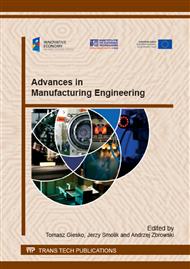[1]
R. Kiessling, Non-metallic inclusions in steel, The Institute of Materials, London, UK (1978).
Google Scholar
[2]
B. Podgornik, V. Leskovsek, M. Godec, B. Sencic, Microstructure refinement and its effect on properties of spring steel, Mat. Sc. & Eng. A599 (2014) 81–86.
Google Scholar
[3]
L. A. Moiseeva, B. P. Moiseev Composition, Structure and Sources of Exogenous Inclusions in Steel, Steel in Translation Vol. 37, No. 7 (2007) 607–613.
DOI: 10.3103/s0967091207070133
Google Scholar
[4]
T. Lipinski, A. Wach, Non-metallic inclusions structure dimension in high quality steel with medium carbon contents, Arch. of Foundry Eng., 3, 9 (2009) 75-78.
Google Scholar
[5]
M. Kivio, l. Holappa, Addition of Titanium Oxide Inclusions into Liquid Steel to Control Nonmetallic Inclusions, Met. and Mat. Trans. 43B (2012) 233-240.
DOI: 10.1007/s11663-011-9603-5
Google Scholar
[6]
S. Yang, Q. Wang, L. Zhang, J. Li, K. Peaslee, Formation and Modification of MgO Al2O3-Based Inclusions in Alloy Steels. Met. and Mat. Trans. 43B (2012) 731-750.
DOI: 10.1007/s11663-012-9663-1
Google Scholar
[7]
S. Saberifar, A.R. Mashreghi, A Novel Method for the Prediction of Critical Inclusion Size Leading to Fatigue Failure, Met. and Mat. Trans. B 43B (2012) 603-608.
DOI: 10.1007/s11663-012-9640-8
Google Scholar
[8]
T. Lipiński, A. Wach, The influence of outfurnace processing on the exploatinal propriety the middle carbon high quality cocstructional steel, Arch. of Fondry Eng. 1, 10 (2010) 93-96.
Google Scholar
[9]
V. S. Gulyakov, A. S. Vusikhis, and D. Z. Kudinov, Nonmetallic Oxide Inclusions and Oxygen in the Vacuum Jet Refining of Steel, Steel in Transl. 42/11 (2012) 781–783.
DOI: 10.3103/s0967091212110034
Google Scholar
[10]
A. N. Smirnov, V. G. Efimova, A. V. Kravchenko, Flotation of Nonmetallic Inclusions during Argon Injection into the Tundish of a Continuous_Casting Machine. Part 2, Steel in Trans. 44/1 (2014) 11–16.
DOI: 10.3103/s0967091214010185
Google Scholar
[11]
A. Srivastava, L. Ponson, S. Osovski, E. Bouchaud, V. Tvergaard, A. Needleman, Effect of inclusion density on ductile fracture toughness and roughness, J. of the Mechanics and Physics of Solids 63 (2014) 62–79.
DOI: 10.1016/j.jmps.2013.10.003
Google Scholar
[12]
D. Steiner Petrovic, M. Jenko, M. Hraes, Study of the morphology of non-metallic inclusions in non-oriented electrical steel containing Cu and Se, Vacuum 71 (2003) 33–40.
DOI: 10.1016/s0042-207x(02)00710-8
Google Scholar
[13]
T. Lipiński, A. Wach, The effect of the production process of medium-carbon steel on fatigue strength, Arch. of Foundry Eng., vol. 10, Issue 2 (2010) 79-82.
Google Scholar
[14]
Y. Wang, Y. Bao, M. Wang, L. Zhang, Precipitation and control of BN inclusions in 42CrMo steel and their effect on machinability, Metall. and Mat. 20/9 (2013), 842-849.
DOI: 10.1007/s12613-013-0805-5
Google Scholar
[15]
D. Spriestersbach, P. Grad, E. Kerscher, Influence of different non-metallic inclusion types on the crack initiation in high-strength steels in the VHCF regime, Intern. J. of Fat. 64 (2014) 114–120.
DOI: 10.1016/j.ijfatigue.2014.03.003
Google Scholar
[16]
M.H. Evans, A.D. Richardson, L. Wang, R.J.K. Wood, W.B. Anderson, Confirming subsurface initiation at non-metallic inclusions as one mechanism for white etching crack (WEC) formation, TribologyInternational75(2014)87–97.
DOI: 10.1016/j.triboint.2014.03.012
Google Scholar
[17]
Y. Hong, Z. Lei, Ch. Sun, A. Zhao, Propensities of crack interior initiation and early growth for very-high-cycle fatigue of high strength steels, Intern. J. l of Fat. 58 (2014) 144–151.
DOI: 10.1016/j.ijfatigue.2013.02.023
Google Scholar
[18]
Y. Bao, M. Wang, W. Jiang, A method for observing the three-dimensional morphologies of inclusions in steel, Met. and Mater. 19/2 (2012) 111-115.
DOI: 10.1007/s12613-012-0524-3
Google Scholar
[19]
Ch. Shi, X. Chen, H. Guo, Characteristics of inclusions in high-Al steel during electroslag remelting proces. Met. and Mat. 19/4 (2012) 295-302.
DOI: 10.1007/s12613-012-0554-x
Google Scholar
[20]
A. Roiko, H. Hänninen, H. Vuorikari, Anisotropic distribution of non-metallic inclusions in a forged steel roll and its influence on fatigue limit, Intern. J. of Fat. 41 (2012) 158–167.
DOI: 10.1016/j.ijfatigue.2011.12.023
Google Scholar


